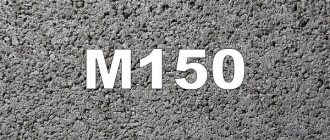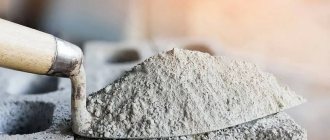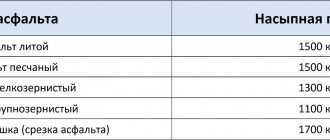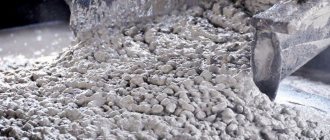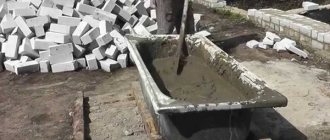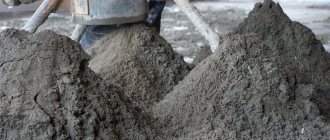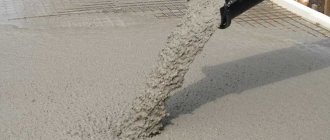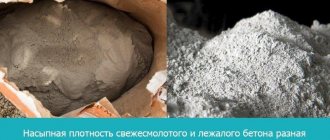The density of cement is one of the main characteristics of a building material. It is defined as the ratio of its mass to its occupied volume. There are many factors that influence the value of this parameter. Read to the end to learn all the nuances of determining the density of a material for preparing ideal building mixtures.
Portland cement - bulk mixture Source obyava.ua
Main properties
Cement is considered a binding building material, which includes clay, limestone, marl, gypsum and other mineral additives. Cement is rarely used in its pure form - the solution is diluted with sand and water.
The main properties that you should pay attention to when purchasing are:
- The rate of hardening of the solution is responsible for the strength and uniformity of the surface layer. An interrelated parameter is the grinding fineness of the dry composition.
- Strength is responsible for the load that the finished material can withstand. According to mechanical indicators, cement is divided into 4 grades: 400, 500, 550, 600.
- The time and volume of heat transfer during hardening of the mixture is regulated by mineral additives. The characteristic is responsible for the uniformity of the coating and the absence of cracks.
- The grinding fraction plays an important role in the density of the future material. The smaller the grains, the stronger the pouring will be.
- The frost resistance of the mixture determines where it is advisable to use the material - indoors or outdoors.
Specific gravity: characteristics of the indicator
The specific gravity indicator makes it possible to determine the mass of 1 cubic meter of cement.
The parameter depends on a number of factors:
- The weight and density depend proportionally on the brand of dry composition.
- Method for preparing the mixture. The coarse fraction retains some voids between the components of the material, which reduce the mass ratio by 1 m³.
- Date of manufacture. During the manufacturing process of the material, friction energy arises between its particles, which increases the volumetric weight of the cement. Over time, the energy weakens and the indicators change.
- The presence of mineral additives increases or, conversely, decreases the value of the parameter.
- Storage conditions. Increased air humidity in the room where the dry composition is stored contributes to an increase in density, which accordingly increases its mass.
In the specialized literature, another name for the parameter is found - the specific density of the substance.
Specific gravity of different brands
People who use building material for private purposes are wondering how much a cube of M400 cement weighs. This is due to the fact that the density of the building material, purpose and mechanical characteristics directly depend on the brand of cement mixture.
Grades 400 and 500 are considered to be the standard of quality. They are used for the construction of large objects, buildings, interfloor ceilings and filling sites. Therefore, the builder must know how many kg of cement is needed for each stage of work.
When constructing large objects, builders more often use the concept of “bulk density”. The specific gravity is affected by the degree of compaction of the material, therefore, when calculating the weight of 1 m³ of M400 cement in bags, it can exceed 3 tons.
Varieties
For example, the sulfate-resistant type is highly resistant to low temperatures, which is why it is used for the construction of non-residential buildings and outdoor work. But this solution takes longer to dry than others. The cement type is used for concreting oil wells, and in municipal construction the material is used extremely rarely.
Kinds
Cement is divided into several groups according to the presence of minerals: Portland cement - clinker predominates with a percentage of 50 to 70, and contains tricalcium silicate. It is the most popular type in construction due to its high strength and speed of hardening; Aluminous cement is crushed clinker, which contains bauxite and limestone. The presence of monocalcium aluminate in the substance determines the speed of hardening. It is demanding on temperature conditions; at subzero temperatures it practically does not harden; magnesium cement – in this type of clinker the main binder is magnesium oxide. It is characterized by high mechanical strength and is used in the production of artificial stone. Another name is Sorel cement; acid-resistant cement - a complex mixture of hydrosilicates of sodium, silicon, fluorine and quartz sand, when mixed with liquid glass, forms a compound that is unstable to water. Used in the chemical industry.
The process of preparing the required solution
Sand-cement mixtures are used for masonry or plastering work. The requirements for the components vary. At the first stage, pour water, then lime and mix until a homogeneous white liquid is formed.
For finishing, only fine-grained clean sand is used. It is recommended to prepare the solution in a large container. On the second, sand is added. Clean from foreign impurities: grass, leaves, stones and other foreign bodies.
If you purchase a ready-made mixture, you must follow the instructions on the package. Add plasticizers if necessary.
Calculation of volumetric weight
To calculate the specific gravity of cement in 1 m3, the formula is used: M/V, where:
The indicator is measured in kg/m³. To convert kg to tons, you need to divide the resulting value by 1000.
Brand of solution
The volumetric mass of the solution varies depending on the brand used and corresponds to the following figures:
- from M100 to M200 - 900;
- from M300 to M500 - 1100;
- sand-cement mixture - 1700;
- cement-perlite and slag compositions - 1000-1400.
Areas of use of brands
During construction, it is important to maintain the compatibility of materials. If the facility uses bricks of grade 100, then the cement mortar for connecting them should be M100. For plastering, leveling walls, and interior finishing work in dry rooms, cement grades M200 and M300 are used.
M600 cement is used only to create structures with increased strength.
How to prepare a solution at sub-zero temperatures
At air temperatures down to -5°C, the solution is prepared according to the standard recipe. If the thermometer readings drop below, the use of special additives is required to protect the seams from fraying. Detergents can be used for these purposes. Experts also recommend adding anti-corrosion substances to the mixture.
To avoid difficulties with the components of the solution, it is recommended to use warm or hot water. In it, the frozen components will quickly acquire the desired consistency.
How much does a bucket of potatoes weigh?
A 10-liter bucket weighs 6.5 - 7.5 kg, and a 12-liter bucket weighs up to 10.3 kg.
The weight of a bucket of potatoes, first of all, depends on the volume of the container itself. For example, 6.5 - 7.5 kg of potatoes can be poured into a 10 liter bucket. The value of this indicator is also affected by the fullness of the bucket - if the seller generously poured a heaping amount of potato tubers, then the total weight will increase.
In addition, the material from which the bucket is made is taken into account. So, in an enamel bucket, the weight of the empty container is added to the weight of the potatoes - about 2 kg
And the weight of potatoes poured into a galvanized bucket with a capacity of 10 liters will increase by about 1 kg.
About 10.3 kg of medium-sized tubers can be poured into a 12-liter bucket, excluding the weight of the container.
How much does a bucket of potatoes weigh? Another deciding factor is the size of the tubers in the bucket. More small potatoes will fit into a bucket than large ones, and the filling of the space will be more dense. But large, elongated potatoes leave a lot of free space in the bucket.
For comparison: if you pour small and large potatoes into two identical containers and compare the weight, then in the first case the bucket will be a little heavier.
Main properties of cement
- Freezing period. It is determined by laying medium-thick cement on a smooth surface. As it dries, it will evenly change its volume.
- Density. Using water to make a cement mixture. After the cement has hardened, water is needed to dry it and also for further good installation.
- Coupling with reinforcement cage. After preparing the solution, it quickly adheres to the reinforcing material.
- Heat dissipation . During hardening, heat is released from it. When this process occurs slowly, the coating hardens very evenly. Also, no cracking is observed in the cement. The time and amount of heat generated can be controlled using mineral elements. They are entirely intended to be added to the solution.
- Grinding grain size. This property affects the drying time and strength of cement. The smaller the grind, the better the strength of the cement.
- Frost resistance. If necessary, you can determine how much the prepared cement can withstand freezing water for some time. Subsequently, the volume of water can increase by 8-9%.
Minimum and maximum screed thickness
SP 29.13330.2011 gives clear instructions on the minimum thickness of the screed layer to ensure the required floor slope: when laying on floor slabs, at least 20 mm, when laying on a waterproofing layer, on a heat and sound insulating layer - at least 40 mm. When covering pipelines (including in a heated floor system), the thickness of the screed must be at least 45 mm greater than the diameter of the pipelines. A smaller layer thickness can lead to cracking and destruction of the screed.
The minimum thickness of the screed layer recommended by experts is 30 mm. The optimal value of the screed is 40-50 mm; an increase in thickness entails excessive consumption of material, is limited by the permissible load-bearing capacity of the base even if light screeds are used, and requires additional reinforcement of the layer with reinforcement.
Specific gravity - characteristic of the indicator
The specific gravity of cement is the ratio of the mass of a given material to the volume it occupies. An alternative name for this indicator is the specific (that is, true) density of the substance.
The specific gravity of cement in 1 m3 may vary depending primarily on the brand of the material being studied.
This indicator is also influenced by some other factors. Among them, material scientists and builders highlight:
- date of cement production;
- method of manufacturing the material;
- storage conditions;
- component composition.
It is believed that the higher the grade of cement, the higher its specific gravity and density, respectively. Because of this, less volume of such material is used when preparing mortars.
Immediately after the production of cement, a certain static energy exists between its particles. It does not allow them to come into strong contact with each other, which is why the volume occupied by the material increases. This in turn affects the specific gravity, reducing it slightly.
The size of its components also depends on the method of preparing cement. The larger it is, the more air voids remain in the material between its fractions. This helps to reduce specific gravity indicators.
If cement is stored in damp conditions, its density can increase significantly. Accordingly, the specific gravity of such material will also increase.
That is why the manufacturer recommends storing cement only in dry and ventilated areas without access to water.
The specific gravity of the cement mortar can be significantly affected by the components of the material . Manufacturers often add various impurities to the binder, which can either increase or decrease the specific gravity of future mixtures.
Additional recommendations
It should be borne in mind that each individual mixture may contain a different number of components and their ratio or quality. Thus, it is quite difficult to accurately determine the weight; only approximately take as a basis the average statistical data based on the brand of the mixture.
Not only the amount of sand matters, but also its fraction. Fine-grained sand is heavier than coarse sand. An increase in voids, with a large fraction, leads to a lighter weight of the entire solution. It is generally impossible to calculate a solution prepared by yourself, since each batch will be slightly different from the previous one.
In general, the brand of composition may vary slightly from the recommended parameters, but in this case a larger amount of solution will be used per 1 m2, which will somewhat compensate for the decrease in strength.
Similarly, with a larger brand, less mixture will be needed per 1 m2. So, when filling the site, you can use other brands instead of M300, both M200 and M400, the results will differ slightly.
The freshness of the cement plays an important role . If the cement was produced more than 1 month ago, then its characteristics are slightly reduced, by approximately 10-15%. Thus, a little more cement is added to the solution.
Drying the solution from the moment of preparation takes about 1-1.5 hours. Subsequently, it ceases to be suitable and begins to form into a single whole. Even adding water will not restore the proper elasticity of the mixture.
Specific gravity of a bag of cement of various brands
When choosing cement, first of all you should pay attention to its brand. It is by focusing on this characteristic of the material that you can choose a truly suitable binder for specific construction purposes.
The highest quality cement grades are M400 and M500. They are most often used for the construction of various buildings and structures.
To calculate how much of these materials you need to take to prepare the mortar, you should know their specific gravity. Its approximate data is as follows:
- the specific gravity of M400 cement in compacted form is 1400-1600 kilograms per cubic meter;
Dependence of cement powder consumption on related factors
You should know how many bags of cement are in one cube of concrete, focusing not only on mathematics and practical methods close to the “by eye” method. This depends on the following factors:
- the desired brand and how quickly the mixture should set;
- plasticity and mobility of the mixture;
- type of other fillers used during mixing.
In fact, you will need to evaluate all the materials included in the mixture. In this case, it will be clear how much concrete can be obtained from the existing powder material or how much cement a cube of concrete will contain after mixing.
Varieties
Cement is a binding substance that can harden in water, as well as when exposed to air. Its main component is clinker. Cement is made by grinding clinker from gypsum and adding mineral additives.
Clinker may include: limestone, nepheline sludge, marl. After adding 20% of mineral additives from the entire mass of the prepared liquid, the characteristics and trends of the source material change. If the volume of additives is more than 20%, then pozzolanic cement is formed.
Due to the active use of cement for the purpose of carrying out work in the construction industry, there are several varieties of it. They differ from each other in composition.
Types of cement include:
- marly;
- lime;
- clay cement in addition to additives of bauxite and slag. It differs from all others in its water resistance;
- sulfate-resistant, which hardens very slowly and has increased frost resistance;
- grouting. It is intended for concreting oil wells;
- the strainer dries quickly;
- hydraulic;
What security systems are suitable for a summer house?
Today, there are many different means of protecting your home and garden from “uninvited guests.” If you do not take into account various mechanical devices and devices, then the main types of security equipment include:
- autonomous security systems;
- remote alarm system for the dacha;
- wired security systems;
- wireless security system;
- GSM alarm system for a summer residence.
With the help of security systems in a suburban area, you can build a highly effective security configuration that will provide protection at three levels.
- Approaches to the house.
- Building perimeter.
- Interior premises.
For each of these levels, an optimal set of devices is selected that will maximize the protection of the summer cottage and its buildings from intruders.
Very often, owners of dachas who have sufficient financial resources try to ensure that the maximum possible security of their houses and dachas is ensured - in this case, alarms are used together with guard guards, which are provided by a specially hired person - a security guard. Its functions include both personal monitoring of an object and the most effective use of security functions and tools that are included in the installed alarm systems.
For those who cannot spend a sufficient amount of money on arranging a security system for their site, we can offer alarm models for their home, cottage, or garage. These fake devices are copies of real alarm elements, which are visually impossible to distinguish from a functioning security system.
What will the density level depend on?
As a rule, thematic construction literature indicates the exact proportional data of all solutions, prepared on the basis of the desired composition. Weight will depend on factors:
- how the drying stage was done.
- clinker grinding measures.
A freshly ground type of cement will always have a lower density. This is explained by the laws of electrostatistics. When grinding occurs, each cement particle becomes magnetized and moves away from the others through a process of intense friction.
The total weight of one cube of cement will be 1100 kg.
The opposite process occurs during transportation or long-term storage. After this, its density level increases up to 1550 kg m2. Other density indicators that can be used to find out how much cement actually weighs include:
- the true density of a building material.
- average bulk density.
Rules for performing calculations
Calculating the bulk density of a material is quite simple. To do this, you do not need to use complex equipment and a specialized laboratory. To determine the necessary parameters, you will need the following devices:
- funnel , the hole in which is sufficient for the free passage of mixture particles;
- graduated cylinder - for measuring the volume of material;
- scales - to determine the mass of a bulk substance.
The process of preparing the required solution
One of the available subtypes of mortars is used - these are plaster and masonry types, which have some differences between each other. The substance must not contain foreign impurities such as roots, stones, grass or clay.
In order to increase the strength of the solution, you need to add appropriate plasticizers to it.
The solution must be mixed in a large container. Initially, water is taken and poured there, then lime, and then thoroughly stirred to obtain a special milk of lime. Then a certain amount of sand is added. You can also prepare a solution using dry and astringent material.
Today, river sand is indeed the most common and sought-after building material. It's all about its density.
To insulate the facade of both residential and non-residential premises, many began to use polystyrene foam. Here is the necessary information about facade plaster using polystyrene foam.
Evaporation, pollution, moisture - all this should be taken into account when renovating the work area in the kitchen. By clicking on the link, you will get acquainted with wall panels for the kitchen made of glass.
Its dry ingredients need to be mixed and water gradually poured into it.
During this process, the resulting liquid must be mixed well so that the solution ultimately has the desired structure. If the solution turns out to be of quite normal viscosity, it does not pour out when the container is tilted to 40 g.
In order to prepare the solution, you need to remember the ratio of the binder filler and the proportions of sand. Solutions that are suitable for plastering. Sand, which should mainly be fine-grained and clean, should include a number of other impurities not exceeding 5%.
From the sand into which clay is taken in production and added at low consumption, a solution of plastic structure emerges. It is more convenient to carry out construction with it, but after it dries it becomes covered with cracks.
For the characteristic indicators of durability and safety of the plaster in its original state, the main role will be played by the granularity. Excessively fine sand requires more binding material to be added to it.
Over time, the solution will become “greasy” and this will lead to the appearance of cracks. They increase the water resistance of the outer layer of plaster. In order to carry out interior plastering work on a house, a lime substance made from special lime (air) is used.
Brand of solution
First of all, the quality of work depends entirely on the chosen brand of substance. When mixing the desired solution, you need to pay attention to ensure that all proportions are correctly observed. The grade of cement is determined by the level of sand added to it.
For more information about different brands of cement, watch the video:
When the cement mortar has already been prepared, it is advisable to add a little detergent (any) 30 - 300 grams to it. Thanks to this, it will gain greater elasticity.
So how much material is there in question?
High-quality, freshly made cement GOST 31108 is a matter with a fairly loose structure that consists of a number of small particles; they look like dust. Microscopic air particles can be found in between.
Cement
Cement in a loosened state is characterized by a bulk density in the range of 1100-1600 kg/m3. This indicator becomes the basis for the percentage of cement in the prepared mixture, which will ultimately affect the strength of the solid solution.
If we take this indicator as a basis, it will not be difficult to calculate the number of buckets of bags of cement. If we take into account the different indicators of capacitive volumes that will be used for measurements, the indicators for a 50-kilogram bag will be as follows:
- 10 liter capacity – 4.2 buckets;
- 12 liter capacity – 3.5 buckets;
- capacity for 16 liters - 2.6 buckets.
For more information on how many buckets are in a bag of cement, watch the video:
Areas of use of grades of sand-cement mixtures
It is believed that a solution of a certain brand must match the rating of the building materials.
Therefore, if you use grade 100 bricks, then the binder should be of the same grade. Ultimately, the prepared solution will be homogeneous.
In this case, you should be very careful.
If any blocks are being built, grade 100 is used for this. When you need to make partition blocks from grade 25 material, then you need to make an appropriate solution. That's about a bucket of 400 rated slurry and 4000/75 rated sand, definitely taking up more space than 5 buckets.
LLC Svoy Master & PoliStyle
Articles:
Construction mixture based on cement-sand
The list of the most common materials on construction sites includes cement mixtures. The basis for them is cement and sand, but to improve the properties, various additives (plasticizers) are introduced into the composition. DSPs are used at almost all stages - from installing the foundation to plastering the walls. The dry mixture only needs to be diluted with water in the proportions indicated on the container and left for several minutes until it reaches the correct state. It is its ease of use that has made it so popular.
How to prepare a solution at sub-zero temperatures?
At -5 degrees there is no need to add additives. In colder conditions, it is necessary to use special products, because the seams may simply crumble. It is also worth taking the main components seriously. For example, difficulties arise with frozen sand.
To prevent this from happening, you need to do it in advance. It can also be placed in a room with a warm temperature regime. The water should be warm or hot. With it, the solution will not freeze.
In addition, the detergent dissolves much better at warm temperatures. In the winter season, you also need to take into account the fact that you need to add anti-corrosion agents.
The specific gravity of cement is a certain indicator of its density and depends on the brand of cement. It is determined by the ingredients of the solution used and the purpose of their use.
Extra heavy concrete: production and applications
Particularly heavy concrete, having a cubic meter weight of more than 2500 kg/m 3, is a specific material that is not used in ordinary civil engineering. They are in demand for the construction of facilities associated with exposure to radioactive radiation.
To increase the density of the material, magnetites, red and brown iron ore, and barites are used as fillers. In the production of especially heavy concrete mixtures, the following are in demand: cast iron shot, scrap, and crumbs.
Specific gravity of cement in 1m3. Volumetric weight of cement grades
Cement mortars, like pure cement, are often used for construction purposes. It has a number of advantages compared to other building materials. That is why it is very important to understand the calculation of the mass required to lay a strong and durable foundation. The main calculation indicator is the volumetric weight or specific gravity of cement.
Factors influencing changes in cement density:
- date of manufacture
- Technological manufacturing features
- Product type and brand
- Conditions under which the material was stored and transported
SNiP cement-sand screed
Cement-sand mortars for leveling floors are widely used in industrial, civil and individual construction. In the latter case, work is not always carried out according to project documentation, and the owners often take responsibility for choosing materials and leveling the base, relying on personal experience, advice from friends or information from the Internet. One of the options for protecting against possible errors in the absence of a project is to refer to publicly available construction industry standards.
Requirements for the design of floors in buildings for various purposes are regulated by the document SP 29.13330.2011 “Code of Rules. Floors”, in which, taking into account the emergence of new building materials and technologies, the introduction of additional safety requirements, the rules applied since 1988 SNiP 2.03.13-88 “Floors” have been updated. Sections of the set of rules determine the general requirements for the structural design of floors, as well as for the constituent elements: coating, interlayer, hydro- and vapor barrier, screed, underlying layer, foundation soil.
As the main criteria for making technical decisions, SP 29.13330.2011 determines the nature and intensity of mechanical effects on the floor, the intensity of exposure to liquids or aggressive environments, temperature conditions of operation, and ensuring sanitary and hygienic requirements. For industrial premises, special requirements are also taken into account, taking into account the specifics of the facility - the possibility of dust formation, the accumulation of static charges or sparking, the ability to clean and clean.
The information provided in the text of the document and in the appendix tables may also be useful for individual developers when choosing the type of floor and its covering, materials and performance of work, including the installation of a leveling screed.
Specific gravity of cement mixture
Name/brand of cement/mixture
| M 100 | M 150 | M 200 | M 300 | M 400 | M 500 | Sand-cement mixture | Cement-perlite mortar | Cement-slag mortar | Cement, during transportation, tends to become enriched with air. In this case, immediately after unloading, volumetric weight of cement will be 1200 kg/m³. Over time, the material will begin to compact, and its density will return to normal - about 1600 - 1500 kg/m³. There are situations when cement is filled with moisture and becomes too dense, reaching the maximum value of 3100 kg/m³. The main factor influencing density variability is the size of the cement chips. When test purchasing materials, it is very important to pay attention to this indicator. Although, unfortunately, checking the density of a substance is not easy. But there is an average that suppliers must adhere to - 1300 kg/m³. While mixing the solution, it is possible to compact it. To do this, you need to fill the container with coarse sand (a compacting agent), then add medium sand, and finally finer sand. |
How much does a bucket of potatoes weigh?
A 10-liter bucket weighs 6.5 - 7.5 kg, and a 12-liter bucket weighs up to 10.3 kg.
The weight of a bucket of potatoes, first of all, depends on the volume of the container itself. For example, 6.5 - 7.5 kg of potatoes can be poured into a 10 liter bucket. The value of this indicator is also affected by the fullness of the bucket - if the seller generously poured a heaping amount of potato tubers, then the total weight will increase.
In addition, the material from which the bucket is made is taken into account. So, in an enamel bucket, the weight of the empty container is added to the weight of the potatoes - about 2 kg
And the weight of potatoes poured into a galvanized bucket with a capacity of 10 liters will increase by about 1 kg.
About 10.3 kg of medium-sized tubers can be poured into a 12-liter bucket, excluding the weight of the container.
How much does a bucket of potatoes weigh? Another deciding factor is the size of the tubers in the bucket. More small potatoes will fit into a bucket than large ones, and the filling of the space will be more dense. But large, elongated potatoes leave a lot of free space in the bucket.
For comparison: if you pour small and large potatoes into two identical containers and compare the weight, then in the first case the bucket will be a little heavier.


